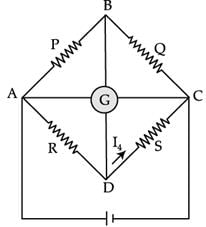Assertion & Reason Test: Current Electricity - Grade 12 MCQ
10 Questions MCQ Test - Assertion & Reason Test: Current Electricity
Directions : In the following questions, A statement of Assertion (A) is followed by a statement of Reason (R). Mark the correct choice as.
Assertion (A): Fuse wire has high resistance and low melting point.
Reason (R): Fuse wire is for small current flow only.
Directions : In the following questions, A statement of Assertion (A) is followed by a statement of Reason (R). Mark the correct choice as.
Assertion (A): The resistance of the superconductor is zero.
Reason (R): Superconductors are used for electrical power transmission.
Directions : In the following questions, A statement of Assertion (A) is followed by a statement of Reason (R). Mark the correct choice as.
Assertion (A): Power rating of resistance is not so important when used in a circuit.
Reason (R): The resistance value changes with temperature.
Directions : In the following questions, A statement of Assertion (A) is followed by a statement of Reason (R). Mark the correct choice as.
Assertion (A): Kirchhoff ’s voltage law indicates that the electric field is conservative.
Reason (R): Potential difference between two points in a circuit does not depend on the path.
Directions : In the following questions, A statement of Assertion (A) is followed by a statement of Reason (R). Mark the correct choice as.
Assertion (A): In the balanced condition of a Wheatstone bridge, there is no current flow through the galvanometer.

Reason (R): The potential of point B and D are the same.
Directions : In the following questions, A statement of Assertion (A) is followed by a statement of Reason (R). Mark the correct choice as.
Assertion (A): Meter bridge wire is generally made of Constantan.
Reason (R): Constantan has a very low temperature coefficient of resistance.
Directions : In the following questions, A statement of Assertion (A) is followed by a statement of Reason (R). Mark the correct choice as.
Assertion (A): Potentiometer is used to measure the e.m.f. of a cell.
Reason (R): Potentiometer is preferred over voltmeter to measure the e.m.f. a cell since it does not draw any net current from the cell.
Directions: These questions consist of two statements, each printed as Assertion and Reason. While answering these questions, you are required to choose any one of the following four responses.
Assertion : In a simple battery circuit, the point of the lowest potential is the positive terminal of the battery.
Reason : The current flows towards the point of the higher potential, as it does in such a circuit from the negative to the positive terminal.
Directions: These questions consist of two statements, each printed as Assertion and Reason. While answering these questions, you are required to choose any one of the following four responses.
Assertion : Voltmeter is connected in parallel with the circuit.
Reason : Resistance of a voltmeter is very large.
Directions: These questions consist of two statements, each printed as Assertion and Reason. While answering these questions, you are required to choose any one of the following four responses.
Assertion : An electric bulb becomes dim, when the electric heater in parallel circuit is switched on.
Reason : Dimness decreases after sometime.














